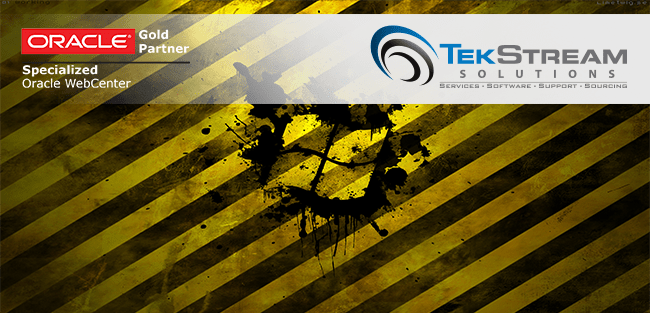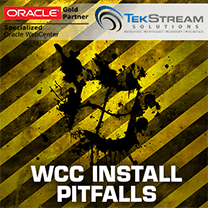Top 10 WebCenter Content Installation Pitfalls and How to Avoid Them

There is nothing like a smooth clean install. You approach the terminal with grit and determination, fly through the installation, and within a blink of an eye, all managed servers are RUNNING! Then… you wake up. *poof* Reality sets in, and that smooth paved road appears to have some twists and bumps. Enterprise level software generally comes with tons of options. If you don’t pay attention to the installation, or don’t do your research prior, you’ll find yourself in uncharted lands without a guide to help you.
Most Oracle WebCenter Content installations are fairly straight forward, so it’s especially frustrating when something goes wrong. It’s supposed to be simple and straightforward. Why isn’t it working? Well, here are a couple of pitfalls to help you to better navigate all of the twists and turns you might encounter!
- Do not install 32-bit WebLogic Server (WLS) on 64-bit Universal Content Management (UCM). This configuration is not supported by Oracle. Although you may not notice a problem when you go through the installation, any future request for support will probably result in a friendly “Sorry, but that’s not supported.” Better safe than sorry, right? Remember to also install WLS with a 64-bit version of Java.
- The Repository Creation Utility (RCU) version has to match the WebCenter Content (WCC, formerly known as UCM) version. It’s all about the schema! As new versions of WCC and RCU are released, they don’t clearly advertise the changes made to the schema. It could be something as large as a new column added to a table, or it could be something as small as the field length changing by one. Although it doesn’t seem like a problem during installation (the connection test results in a happy green check), it may come back to haunt you the first time you try to check-in content, and get a database error.
- When installing WCC on a Linux platform, remember to set your limit.conf file. This is where you set the hard limit and soft limit of a resource on your system. Set your number of open files (nofiles) to something manageable, like 4096. Without setting this, the default is substantially lower than 4096. Make sure this is set properly so your system can handle all the files needed to be opened by your Oracle applications.
- If you are using X-terminal to perform a remote installation through Putty, remember to enable the X11 features in Putty. It’s very easy to overlook this. You open up a new putty session, and dive into the environment. After swimming around, you go to run a program. You wait for the program to come up, but get feedback about “not able to display” instead. Before calling up your local help desk to yell at them for not installing Xwindows, check to make sure your X11 is turned on in Putty! It may also be a good time to check and see if your emulator is running. Don’t fall victim to an ID-10t error!
- When installing SOA, set DB processes to 200 BEFORE running RCU. Don’t make the changes after running RCU, and certainly not during, but before. These changes will be applied to the repository schemas created, and will save you from a headache later down the road.
- When creating the repository, remember to write down and save the password! It has happened to me, it’s happened to others. You finish an install, and close that chapter of your life. But like a good zombie movie, the environment rears its ugly head, and you need that password to check your DB connection. That’s when it occurs to you… “I have no Earthly idea what it is!!!” You scramble to find any scrap of paper relating to that time period, but sadly none contains that golden password.
- Know whether you are installing for development or for production. A production system is more secure, while a development system is more relaxed with security and protocol. Knowing the difference, and adding the password file, could save you some time!
- Map out your install before you do it. Ports, IP’s, server names, clusters, machines, Database access information, and password requirements are great to have handy so you don’t have to search for it, or worse, create something on the fly. Taking time before the installation to research and plan will help minimize mistakes. Have all your stuff written down before the install so you can spend more time on the installation steps.
- When installing on Linux, pay attention when using command lines. More specifically, know when you are using Root, and when to disengage. All you need to do is run startWebLogic.sh one time as root, and suddenly all the folders permissions change! Your WCC won’t find the files it needs. The Inbound Refinery (IBR) managed server runs around in a circle. Spaces locks itself in a pantry. SOA goes AWOL! There are only two times in a standard installation when you’ll need to run a command as root, when you run RCU and when you create the central inventory during the WCC code install.
- Installing on Windows, be sure to change 8dot3 first. This is Microsoft’s default naming convention. Files and folders generally are limited to eight characters, with a three character extension. As an example, we have file names like autoexec.bat, or config.sys. When you try to browse through your file system in command prompt, you’ll see that the folder “Program Files” ends up “PROGRA~1”. It’s eight characters, and fits neatly into that MS mold. Turning this off is required to use WCC. Files and folders exceed the eight-character limit. But why not just turn this feature off later? During the installation, configuration files are written with folder paths included. These folder paths use “MIDDLE~1” instead of “Middleware”, which may cause problems later on down the road. In one example, we had changed the 8dot3 much later in the process. When we tried to start up the servers, it failed because the service tried to write to a file, but could not find the file because it didn’t know that folder structure.
Slow down!! Typos magically appear when you rush through an install! It doesn’t matter how good you are, or how much experience you have, we are all capable of overlooking or forgetting a step. Why read a blog about common pitfalls only to overlook those exact pitfalls? You’ll end up kicking yourself twice… once for messing up, and once for not listening. Hope these little tips help! I know they certainly would have come in handy for me in the past!
Looking for more help with your installs? TekStream is positioned to help. Complete this form and an installation expert will contact you immediately.

